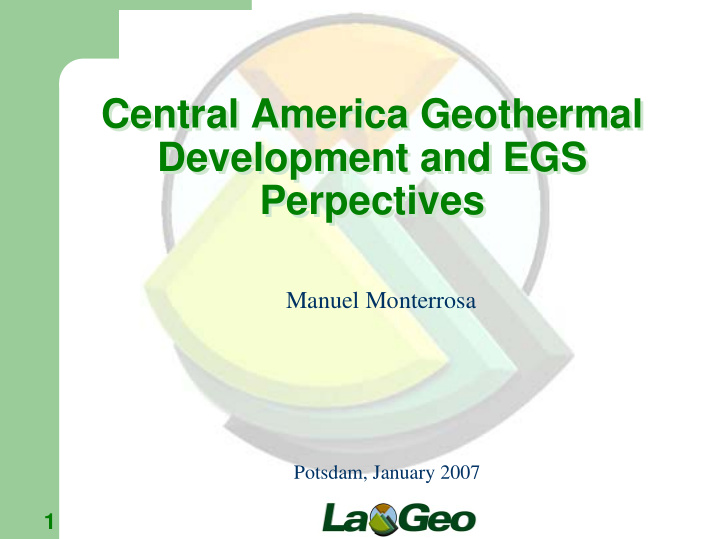



Central America Geothermal Central America Geothermal Development and EGS Development and EGS Perpectives Perpectives Manuel Monterrosa Potsdam, January 2007 1
CONTENT CONTENT • Central America Electricity demand • Geothermal field in C.A. • Hydrofracturing Test project by SHELL • The Berlin Geothermal field • Long term test by LaGeo • Results of the test • Conclusion 2
GUATEMALA HONDURAS EL SALVADOR EL SALVADOR � � NICARAGUA Countries 6 Installed Capacity 8,889.6 MW C O Net Generation 33,566.0 GWh S T A R I C GEO Generation 2,575.5 GWh A GEO Installed Capacity 427.4 MW P A N A M Á % GEO Generation 7.7 % Peak Demand 5,169.6 MW Electricity Growth 6.0 % annual Central America Electricty demand 3
Installed Capacity and Peak Demand 2,500.00 2,000.00 1,500.00 MW 1,000.00 500.00 - Costa Rica Guatemala Panamá El Salvador Honduras Nicaragua 1,961.10 1,983.10 1,555.90 1,197.90 1,449.40 742.20 Capacidad Instalada 1,761.1 1,728.1 1,124.0 905.0 1,249.4 527.0 Capacidad Disponible 1,389.60 1,290.10 946.30 829.00 1,014.00 482.80 Demanda Máxima 4
Power plants in operation Ahuachapan 95 MW Berlin 56 MW Under construction 49.2 MW Power plants in operation Zunil I 19 MW Amatitlan 5 MW 5
Power plants in operation Momotombo 47 MW San Jacinto 10 MW Power plants in operation Miravalles 163 MW 6
Zunil I, GUA Ahuachapan, ELS Berlin, ELS Momotombo, NIC San Jacinto Tizate, NIC Miravalles, CR 7
HFR (EGS) test carried out by Shell � The main objective of the project was to explore the feasibility of commercial HFR energy generation. � Well TR-8A at the Berlin field was selected due low permeability and relatively high temperature (250 °C, 7 l/s at 25 bar). � The test was carried out in two phases June 28-July 17, and August 28- Sept 3, 2003 in total 40 days. � Two separated feed zones were fractured 1753 and 2,200 m. � A comprehensive monitoring was undertaken, fluids chemistry, seismic monitoring, pressure and pumping parameters, etc. 8
9
Figura No. 1 Estimulacion hidráulica del 28 de junio al 17 de julio 2003 10
11
Injection test using HFR pumping system � After the Shell´s test LaGeo acquiered all the equipments. In 2005, decided to repeat the test for a longer period of time (120-240 days for 24 hour a day). � The equipments were reinstalled in well TR- 8A and the test start on September 2005. � The main objective was to evaluate the pressure interference in order to install a permanent pumping system at 250 l/s at 50 bar 12
13
CAUDAL (kg/s) y WHP (barg) 10.000 20.000 30.000 40.000 50.000 60.000 70.000 80.000 90.000 0.000 14 01/01/2005 15/01/2005 29/01/2005 12/02/2005 26/02/2005 12/03/2005 HISTORIAL PRUEBA DE BOMBEO POZO TR 8A 2005 26/03/2005 09/04/2005 23/04/2005 07/05/2005 TR-8A kg/s TR-10 kg/s TR-1C kg/s TR-1A kg/s TR-10A barg 21/05/2005 04/06/2005 18/06/2005 02/07/2005 16/07/2005 30/07/2005 13/08/2005 27/08/2005 1 10/09/2005 24/09/2005 2 08/10/2005 22/10/2005 05/11/2005 19/11/2005 3 03/12/2005 17/12/2005 31/12/2005 14/01/2006 28/01/2006 11/02/2006 25/02/2006 11/03/2006 25/03/2006
Results of hydrofracturing jobs � Any fluids return were observed during the pumping test, according the tracer results. � The seismic level was much lower than the expected. � The injection capacity of the well TR-8A was improved after the injection test. � The long term injection test indicate there are any pressure interference between injection wells, therefore a permanent pumping station could be used. 15
Conclusions. � The geothermal development is an sustainable energy resource alternative for the Central America countries electricity demand � There are some posibilities to receive incentives to the geothermal developer due to most of the countries in the region are considering as national energy estrategy the development of indigenous energy resource like geothermal. � At the momment, the total installed capacity from geothermal energy reach 427 MW, contributing with 7.7% the whole energy consupmtion 16
Conclusion .. � The Hydro Fracturing Rock (HFR) test did by SHELL and the long term injection test did by LaGeo in TR-8A has been demostrate that is possible to inject brine (200 kg/s at 160-180°C) with pressure higher than 100 bar without pressure interference or thermal breaktrought in the surrounding wells.No evident seismicity was related with both test � The feasibility to continue the hydrofracturing in low permeability wells has been done in order to improve its injection or production capacity 17
Recommend
More recommend